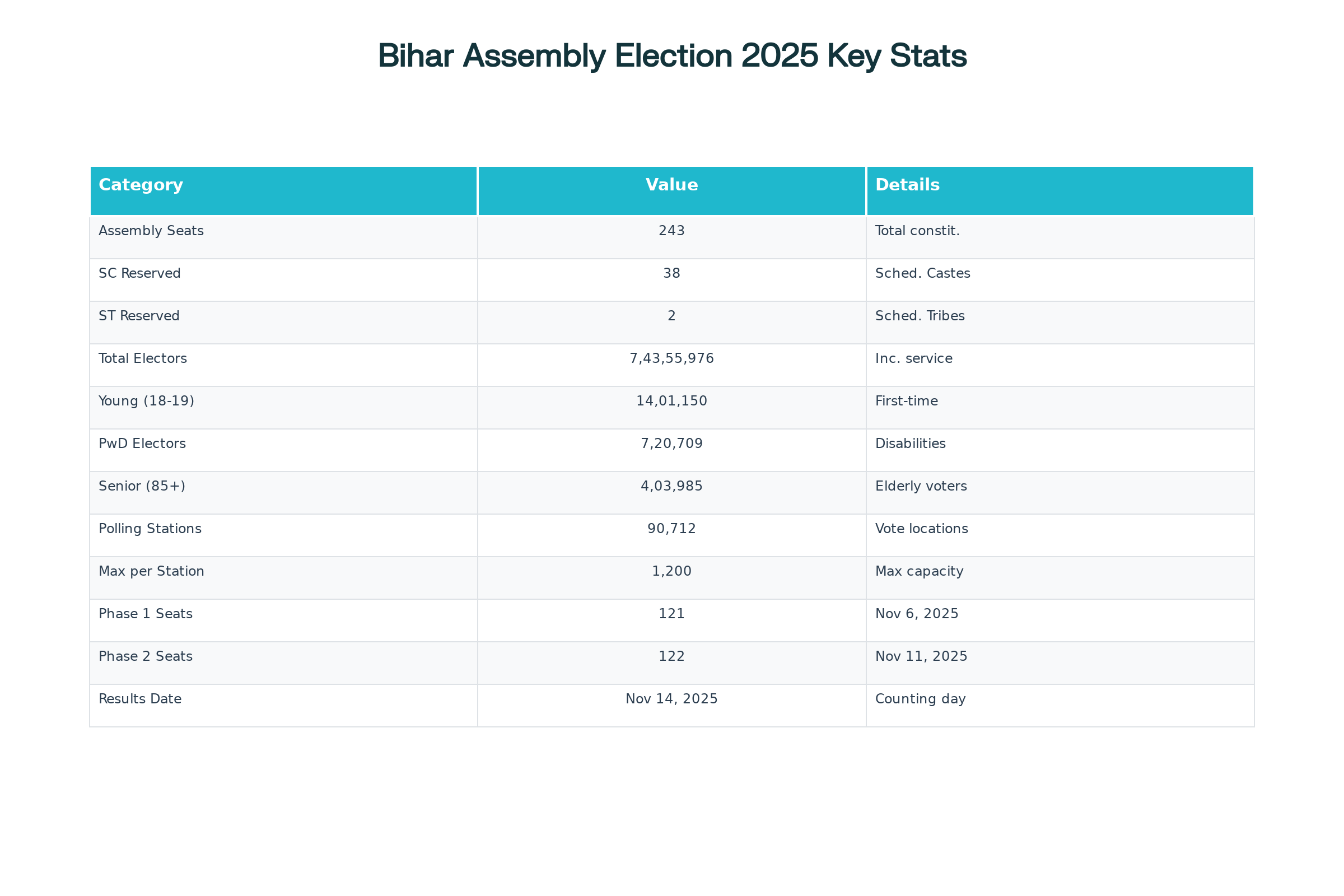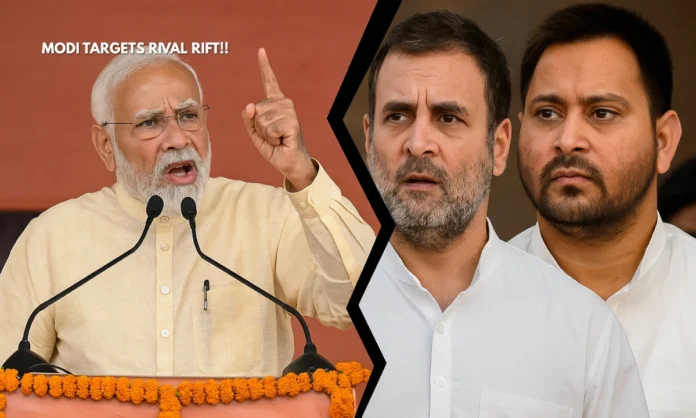Key Highlights
- PM Modi alleges fundamental incompatibility between Congress and RJD, comparing them to “water and oil” during Muzaffarpur rally
- Prime Minister claims receiving reports of widespread conflicts between Congress and RJD leaders across Bihar constituencies
- Opposition alliance faces internal discord with candidates fielded against each other in multiple seats ahead of November elections
PM Modi’s Sharp Attack Reveals Opposition Cracks
Prime Minister Narendra Modi delivered a scathing critique of the Mahagathbandhan alliance during his rally in Muzaffarpur on October 30, 2025, alleging deep-seated rifts between the Congress and Rashtriya Janata Dal (RJD). The PM Modi Congress RJD rift allegations emerged as a central theme when speaking to a massive gathering just a week before Bihar’s crucial assembly elections. Modi claimed that reports of infighting between Rahul Gandhi and Tejashwi Yadav’s parties were pouring in from across the state. The Prime Minister’s “water and oil” analogy highlighted what he described as fundamental incompatibility between the two major opposition parties, suggesting their alliance exists solely to “grab power at any cost so that they can loot Bihar”.
The PM Modi Congress RJD rift narrative comes at a critical juncture when the Mahagathbandhan is struggling with visible seat-sharing disputes and organizational challenges. The Prime Minister’s assertion that their rallies are nothing but a “sham” reflects the BJP’s strategy to exploit apparent weaknesses in the opposition camp. This calculated political offensive aims to undermine voter confidence in the opposition alliance’s ability to provide stable governance in Bihar.
Ded shana forgot these days you can mix water with petrol too, there's a minister in cabinet whose son's company just crossed $1B valuation doing that "Like Water And Oil": PM Says Rift Between Rahul Gandhi, Tejashwi Yadav's Parties https://t.co/pZeFQFSbcD via @ndtv
— Vijay Raj (@RajNadar6) October 30, 2025
Internal Discord Threatens Opposition Unity
The PM Modi Congress RJD rift observations have substantial ground reality backing, as the Congress and RJD alliance has indeed shown visible signs of strain in the lead-up to the Bihar assembly elections. According to recent reports, the two major partners of the Mahagathbandhan have fielded candidates against each other in at least five constituencies, including Narkatiaganj, Lalganj, Vaishali, Sultanganj, and Kagalgaon. The RJD’s decision to potentially contest against Congress state president Rajesh Ram in the Kutumba Assembly constituency has further escalated tensions within the alliance.
The PM Modi Congress RJD rift assessment reflects deeper coordination challenges, with alliance leaders acknowledging that seat-sharing arrangements remained unresolved even as nominations closed for the first phase of elections covering 121 seats. The Communist Party of India, another key ally, has also fielded candidates against Congress nominees in multiple constituencies, including Rosera, Rajapakar, and Bihar Sharif, creating a three-way contest within the alliance itself. This internal competition has led to confusion among party workers and sent mixed signals to voters about the alliance’s organizational strength and commitment to unified opposition.
The PM Modi Congress RJD rift analysis points to deeper ideological and strategic differences between the Congress and RJD leadership. While both parties officially maintain their alliance commitment, ground-level coordination has faltered, with local leaders pursuing independent candidate selection strategies that often conflict with broader alliance objectives.
PM Modi’s Five-Point Critique Of Opposition Rule
Building on the PM Modi Congress RJD rift theme, the Prime Minister systematically attacked the RJD-Congress alliance using what he termed their “five identities”: Katta (country-made pistols), kroorta (cruelty), katuta (social resentment), kushasan (misgovernance), and corruption. This structured criticism aimed to remind voters of the alleged failures during previous RJD rule, particularly the period from 1990-2005 often referred to as “jungle raj” in Bihar’s political discourse.
The PM Modi Congress RJD rift allegations gained historical context when Modi specifically referenced crime statistics, claiming that around 35,000 kidnappings occurred during the RJD regime in Bihar, painting a picture of lawlessness and state-sponsored criminality. Between 1992 and 2004, Bihar reported 32,085 kidnapping cases, making the state synonymous with extortion and fear, with murder cases reaching 3,643 in 2001 and 3,771 in 2003. The Prime Minister’s rhetoric sought to establish a direct connection between past RJD governance and contemporary security concerns.
The PM Modi Congress RJD rift strategy involves positioning the current NDA government as a stabilizing force that transformed Bihar from an era of “jungle raj” to improved law and order. Modi emphasized that the NDA wants to preserve cultural heritage and ensure comprehensive development of all states, including Bihar, contrasting this vision with what he characterized as the opposition’s focus on power acquisition rather than governance.
Chhath Puja Controversy Becomes Political Flashpoint
The PM Modi Congress RJD rift narrative expanded to include religious sensitivities when the Prime Minister launched a fierce attack on the opposition over alleged insults to Chhathi Maiya, Bihar’s most revered deity associated with the Chhath festival. Modi’s criticism stemmed from Rahul Gandhi’s remarks describing PM’s Chhath celebrations as “drama,” which the BJP characterized as an insult to the deeply religious sentiments of Bihar’s people. The controversy escalated when BJP IT Cell chief Amit Malviya accused Gandhi of recycling previous year’s Chhath photographs, suggesting insincerity in his religious observance.
The PM Modi Congress RJD rift accusations gained emotional resonance through the Chhath Puja controversy, which has become a significant campaign issue. Modi asked the Muzaffarpur crowd whether Bihar would tolerate such alleged disrespect toward their sacred traditions. The crowd’s thunderous “no” response demonstrated the emotional impact of religious symbolism in Bihar’s electoral politics. Home Minister Amit Shah further amplified the controversy by claiming that Gandhi had insulted not just PM Modi but all Chhath devotees who pray with sincere hearts.
The PM Modi Congress RJD rift messaging through religious dimensions adds cultural authenticity to the BJP’s political strategy, as Chhath Puja represents Bihar’s most widely celebrated festival with deep emotional connections across caste and community lines. The central government’s initiative to secure UNESCO’s Intangible Cultural Heritage status for Chhath festival further strengthens the BJP’s positioning as protectors of Bihar’s cultural identity.

Bihar Assembly Election 2025: Key Statistics and Schedule
Final Assessment: Electoral Implications Of Opposition Disarray
The PM Modi Congress RJD rift strategy reflects sophisticated electoral calculations aimed at exploiting visible cracks in the Mahagathbandhan alliance. The “water and oil” metaphor effectively communicates the fundamental incompatibility thesis to Bihar’s voters, suggesting that opposition parties lack the cohesion necessary for effective governance. With Bihar’s 7.43 crore registered voters preparing for the two-phase elections on November 6 and 11, 2025, these internal opposition conflicts highlighted through the PM Modi Congress RJD rift campaign could significantly impact electoral outcomes.
The PM Modi Congress RJD rift controversy reveals deeper challenges facing India’s opposition parties in maintaining unified fronts against the BJP-led NDA. While statistical improvements in Bihar’s law and order situation since 2005 provide substantive backing for BJP claims, the opposition’s inability to present a cohesive alternative strengthens the ruling alliance’s prospects. The religious controversy surrounding Chhath Puja adds an emotional dimension that could influence voter sentiment beyond traditional political calculations, particularly among Bihar’s rural and traditional constituencies who hold these cultural symbols sacred.


